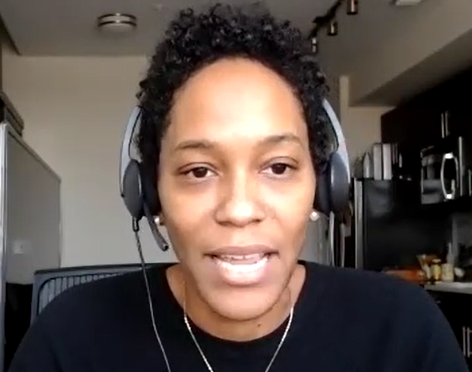You have /5 articles left.
Sign up for a free account or log in.

Amelia Parnell
“Data” is a four-letter word in some quarters of higher education, even as many people call for colleges and universities to get better at using data and analytics to support institutional decision making.
Plenty of academics equate discussions about data with an overemphasis on efficiency or productivity or accountability, and many worry that college leaders will put algorithms and numbers ahead of thoughtful analysis.
Amelia Parnell strongly believes in the power of good information to help college faculty and staff members make better decisions. But in her book, You Are a Data Person: Strategies for Using Analytics on Campus (Stylus Publishing), Parnell describes an expansive view of data-informed conversations that just about everyone in a campus community can and should be able to participate in.
Parnell, vice president for research and policy at NASPA: Student Affairs Administrators in Higher Education, joined Inside Higher Ed’s Key podcast for a conversation about the different ways that professors, administrators and staff members can use data in their everyday work and contribute to important discussions across the institution, whether they consider themselves data people or not.
An edited transcript of that conversation follows.
***
Inside Higher Ed: How do you define a data person? How widely does that tag apply on a typical college campus? I think there are people who tend to think of themselves as not data people at all.
Amelia Parnell: The title of the book, I did that by design to be catchy, but with the nuance that I did not say, “you are a data scientist” or “you are a data analyst.” I put it that way so it would open the door for more people to say they would accept that they have to use data or some type of information in their daily work.
But for those who would say, “I’m not really working in a data office, I’m not an institutional researcher and I don’t come close to using data as some others do,” I think that’s OK. But I do want to make the case that data use and information use is a part of everybody’s job. So a little bit of the focus of the book will be on teasing out for the reader some of the things that connect to making data-informed decisions, things that we might not necessarily consider to be a data-oriented role but does have an adjacent effect on it.
Inside Higher Ed: Let’s break that term “data person” down. How do you define data, and how does that affect how you think about what makes just about everybody in one way or another a data person?
Parnell: In the most simple way, data is information. That data can be robust, it can be comprehensive or it could be very simple. So when someone tells me, “I’m not a data person,” I typically say, “but you are a data person.” They say, “no, I’m not.” And I say, “let me tell you why you are.”
Did you check the weather today? And they would say, “well, of course I checked the weather.” And I would say, “what did it tell you? How many degrees will it be outside?” And they’ll answer that, and I’ll say, “that’s an information point.” And at some point, if you look at trend weather points over the week, now you’re building a bit of data collection, so to speak. So in its simplest form, I think of data as being collections of information, and you use it in a lot of different ways to make a lot of different decisions. So to say that you are a data person, that just means to me that you are in the regular, routine habit of using information to make your best decisions. The goal is not to label anyone specifically or exclusively as a data person, but to say, you have that identity and use it more often than you think.
Inside Higher Ed: Are there things about the current moment we’re in that make it more important than it might have been before for the typical college administrator, the typical faculty member, to think of themselves in this way? I’m curious whether you could have envisioned this book being written 20 years ago, or even 10 years ago. Or are there things about today that sort of require more of us to be what you would define as a data person?
Parnell: It’s a yes and no for me in terms of 20 years ago. From a relational standpoint, those who read the book will see that it does focus pretty heavily on collaboration, the idea of creating a data climate in a culture in which professionals embrace the opportunity to work together and share their respective strengths.
Twenty years ago, that type of thing would have been absolutely relevant. But there was not nearly as much conversation about uses of data for predicting outcomes and prescribing certain interventions and things like that. If the book had come out then, I don’t know if it would have landed the same way. We now have a lot more pressure to show with outcomes how things are working, how things are going … The timeliness of a book like this to help people not see data as something that’s scary or punitive or competitive, or detrimental to how they want to do their work, I think the time is right for that.
Inside Higher Ed: When we at Inside Higher Ed write about data initiatives or have discussions about the use of data to influence decision making, we often get pushback from people who view the emphasis on data as—pick your poison here—either promoting excessive accountability or efficiency or productivity, which are sort of dirty corporate words in certain circles, or as reductionism. How do you describe the importance of your pretty broad definition of data in ways that avoid provoking the people who tend to take that critical point of view?
Parnell: There are a couple of different ways I typically describe it. The first when someone says, “let’s meet together and have … a data-informed discussion.” Oftentimes somebody’s going to say, “who’s coming with the metrics? Who’s going to walk us through the dashboard or show us some type of visualization?” And that’s good. The regular use of data to look at performance and operations and productivity, there’s nothing wrong with that.
But if the conversation becomes exclusively that, it creates a space where you could easily have two colleagues who are both working on a particular program, and someone says “show me your data.” And if one’s data may indicate higher uptake than the other, that usually leads to a conversation about, what’s wrong with the one who doesn’t have the higher outcome, and should we change things? And now these two professionals who both came to a data-informed conversation are now in competition with each other. If you extrapolate that out, [you] could easily have an environment that becomes competitive. You’re now jockeying for resources.
One of the most concerning comments I got was in a reception. I was talking with somebody who worked on the campus as a VP. And they told me, “I have a close relationship with the IR director, because data is power.” That told me that in any data conversation you have, if you’re not careful, communicating the importance of using data could turn into something where it makes people uncomfortable about sharing things that are not going well, or even nervous about sharing things that are going well.
I don’t think the goal with any of this conversation is to somehow suggest that we should no longer care about outcomes or operations. We’re running multimillion-dollar businesses, so we have to look at those things. But in order for those outcomes to show up the way we want them to, the emphasis on context, communication, collaboration are equally as important.
So I hope that this book really promotes the idea that people can bring a lot of different strengths and abilities to a conversation. Use of data is just one part of it. It doesn’t always have to be metrics. It can be qualitative data. I’m really hoping when someone sees the title of this book, they might say, “this is the book for me,” because they’ve been in the conversation where they’ve felt a little anxious about the overall goal and how their work might be situated in that.
Inside Higher Ed: You have something you call the data identity framework, which helps lay out the different ways that people can contribute to conversations and decisions about data. Can you tell us a little bit about the data identity framework and why it’s important?
Parnell: If someone brings up a data-informed conversation, you have to actually have the data and you have to have some ability to actually analyze it and determine what’s the right computation. That’s the research component.
But communication and conversation are also equally as important. You could easily have a situation where someone comes to the meeting with a report and they’ve done extensive analysis, but when it comes time to explain it, someone in the room is saying, “I’m not really getting it. I’m not really sure what these numbers mean.” To have somebody in the room who can actually translate a little bit there and consult and say, “hey, let’s connect this point to that point,” that really helps. So those would be two, research and analysis and communication and consultation. But curiosity and inquiry is a really important piece here.
I’ve been in a lot of conversations where someone said, “wouldn’t it be nice to know …” and they [ask] some type of random question. Being able to ask a clear question helps you make sure that you’re using that analysis in the most appropriate way, so that’s number three.
The fourth would be campus context. Oftentimes you might hear someone say, “Doug and Amelia have worked at the university for the last 15 years.” They might assume that Doug and Amelia have seen everything and that might not be a reason to … involve them. Instead, I say that would be a reason to invite them for sure. They’ve seen trends, they’ve seen initiatives start and finish, they’ve seen things come and go, and so that bring that campus context.
Number five would be industry context. If you’re working at a small college, for example, and you have some trends that show a particular level of participation for a student group, you might belong to another national association focused on small colleges, and you can say our college is situated similarly, or not so similarly to other small colleges across the country. That helps, too.
The last is strategy and planning, the ability to execute a course of action. Let’s say you’ve got the right information that you need to answer the perfect question, and you know the context of the campus and how it’s situated nationally. And you want to figure what to do. What I’m claiming in the book is we all have a little bit of all of these things. The goal of a data-informed decision-making process is to use the information you have to address a core need and make an informed decision.
Inside Higher Ed: Whether people were attracted to this conversation because they thought it was a good thing, or because they figured it was a discussion with the devil about data, I’m picturing—and I’m stereotyping here—an English professor who might say, “I teach these books and that’s what I do. That person, I suspect, is only thinking about data-driven decisions around which programs are performing well and which ones should we get rid of.” What are some of the kinds of conversations and decisions that are maybe less obvious that you would think maybe would be attractive and important to someone like an English professor?
Parnell: The first point I’d make is that not all of every single data conversation has to take place on a very public stage. There could be many more conversations between colleges, between professors, that never actually go outside of the division and can lead to great outcomes.
For example, I think it’s probably routine and commonplace for us to look at things that relate to outcomes—to what extent the students graduate, does this program produce a certain result. In the book I’m making the case that we should also look at needs assessments as well as process assessments. Those types of things actually lead to better outcomes. Using that faculty member, I could see something that many professors probably already do, a real-time poll. Let’s say they’re in the classroom setting and they’re about to discuss a particular reading, and they want to get a sense of if the students have felt like they really understood the material. And so doing a live poll, it doesn’t have to be fancy or sophisticated, but that’s a real time way to check the process.
I can see a community college counselor who’s working on orientation of students, looking at their materials to see if those materials have enough various formats to address students needs. Are they offered in multiple languages? Are they recorded so that students who are visually impaired might be able to listen? Those are types of ways to do assessments that relate more to what the students need at the time. And if it turns out something needs to be adjusted, that’s a real-time use of data that you can collect specific to what students need.
I could see a residence life administrator seeing low participation in a community-building activity. And it might be tempting to go straight to the outcome. Let’s say that activity’s hosted monthly. I can see somebody saying, “well, if nobody’s coming, let’s go ahead and cancel it.” Instead, maybe look at the process. What time of day is it offered? What’s the material that’s going to be discussed in that particular activity? Could it be tweaked a little bit?
Inside Higher Ed: A lot of the worry about a data-driven culture is that the data can and will be used against me in a court of tenure or a court of budget cutting. What is the pushback you tend to hear most against use or overuse of data to influence decision making?
Parnell: I see an emerging need that is probably now more prevalent than ever, which is strategic communication and context setting. There can be an overdependence on data. And without the context, you could easily jump to quick conclusions and make decisions that are not appropriate for what you’re talking about. There’s always going to be a need to situate most decisions with data. And I oftentimes make that joke that data don’t drive—they don’t have a car, you know—but most times data inform.
The data really can show you kind of the current state of things. The decision making is still going to be ours to make. It doesn’t matter how fancy your artificial intelligence is going to be or your predictive model—at some point some human person is going to have to decide what to do.
Using that same weather example, if I look out at my forecast and it says tomorrow’s going to be 70 degrees, the forecast doesn’t say, “wear shorts.” It just tells you it’s going to be 70 degrees. I have to decide what to do after that.
So making those decisions is often tough, and I think that the communication part is really critical. And again, back to the purpose of the book, it’s to spark conversation, so if you have someone with some data and information that probably are useful, and they want to make a decision, they need to talk to colleagues and share amongst each other what’s really going on.
So that contextual piece, if it’s missing, it does create that climate that you just described, the one where people are definitely nervous, all types of reasons why people should be concerned about the misuse or overuse of data, or depending on it in inappropriate ways. But on the flip side, you get to have a group of colleagues that are coming with their best strengths to the table and sharing what they have. It’s like a buffet. Everybody gets a little bit of piece of the meal, and it’s better when you share than trying to do it all on your own. I know this sounds cheesy, but that’s really the vision that I had when I was writing it.
Inside Higher Ed: One of the biggest tensions I’ve seen around data over the years is this question of their use for internal or external purposes. It seems like you’re more focused mostly on internal improvement versus external accountability. Am I hearing that right?
Parnell: I’m greedy enough to want both, but I think starting internally will lead to the external outcomes that we’re hoping for. I think internal culture and climate building of collaboration will eventually lead to a shift in the way we do our work. I think the result of that will be students who actually can find that regardless of what office they go to, they’re working with professionals who have had some intentionality and they know where to direct them to next. As a result, students have a better sense of what they’re learning and how, and that shows up as they start to move toward completing a credential. And I could easily see accreditation conversations shifting that way, too. I just see a great need for us to really establish that type collaborative environment.
Inside Higher Ed: There are people who think higher education isn’t data-focused enough. That leads to a question of, do we not have enough data? Do we have the wrong data? Do we not understand the data we have? Which of those is true? Which is the bigger problem in your eyes?
Parnell: I think we have a lot of data. I think there’s a lot of opportunity there to do some different types of analyses. And I think that’s where we get into spaces where you move into predictive modeling, and even from predictive to prescriptive decision making, and things like that. So I don’t see it so much as an issue of we just need more data.
I don’t even think it’s necessarily that we have the wrong data, per se. I do think there’s a place to go back to the questions that we’re trying to answer, though, and whether the data that we have are appropriately paired for the questions that we want to find the best answers to. I also think that there’s this culture of quick, fast, I need to know now. You know, this particular outside entity needs this. We need to get this answer right now. And the faster we move, the more we lose the opportunity for the contextual pieces that are so critical. So if it truly is I got a phone call and someone wants to know what is the number of students who graduated within the last five years with this particular major. And without the context of knowing what that information will be used for, you could miss an opportunity to talk about more than just the number of students who graduated, but why.
So I don’t think that we have a shortage of data. I don’t even think we have a shortage of good data. I think that we have a misalignment of putting that good data toward the questions that we need to answer most with the right context, and that takes time. And that time should be spent collaboratively across the campus.

.png?itok=gjLy_rS9)







